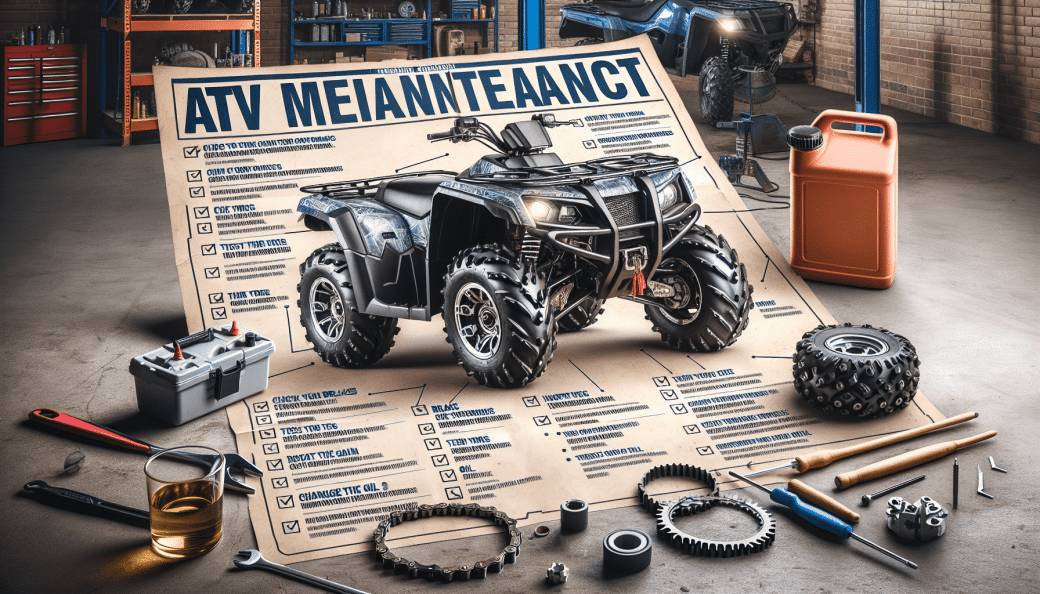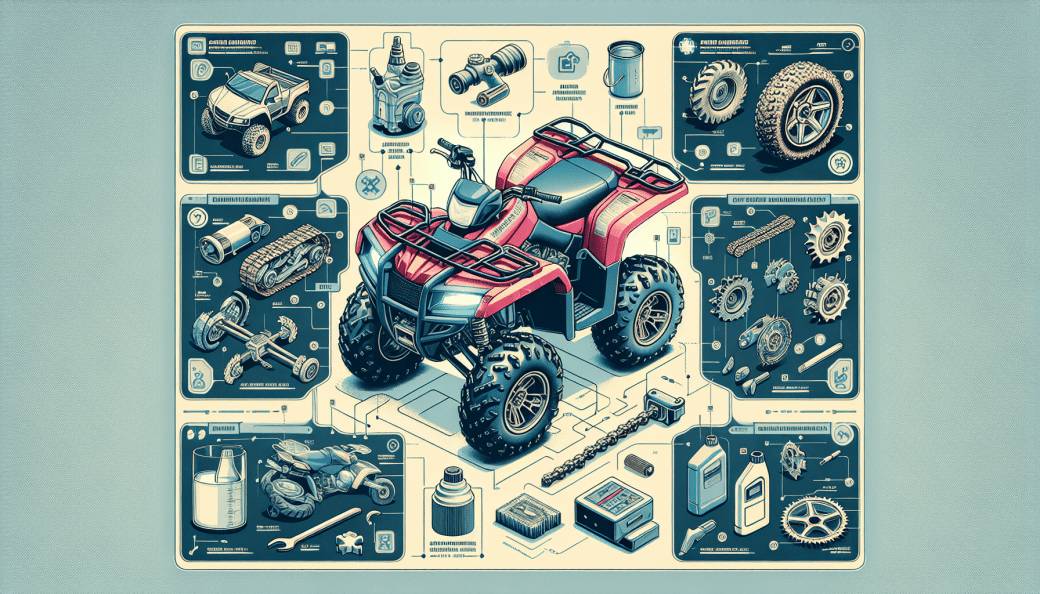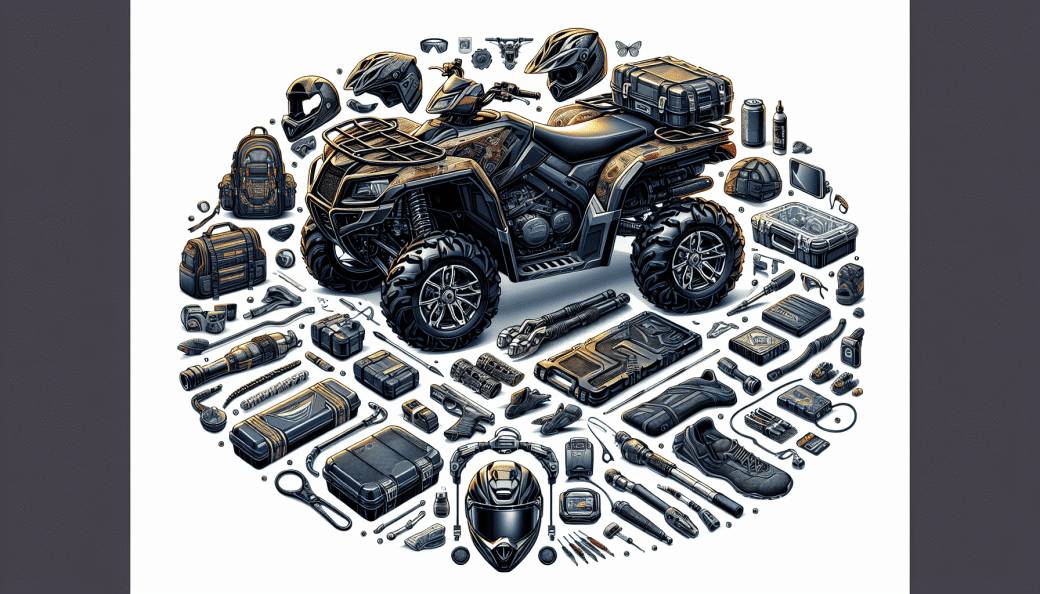If you want to get the most out of your ATV and keep it running smoothly, it’s crucial to stay on top of maintenance. From checking the tire pressure to changing the oil, taking the time to complete a regular maintenance checklist can help prevent costly breakdowns and keep your ATV performing at its best. In this article, we’ll provide you with all the essential steps you need to take to maximize your ride and ensure that your ATV is always ready to hit the trails. So grab your toolbox and let’s dive into the world of ATV maintenance! Whether you’re a seasoned ATV rider or just starting out, proper maintenance is key to maximizing your ride and ensuring safety on the trails. By following this comprehensive ATV maintenance checklist, you’ll be able to keep your vehicle in top condition and prolong its lifespan. From regular inspections to oil and filter maintenance, battery care, brake system checks, and more, we’ll cover all the essential tasks you need to perform to keep your ATV running smoothly.

Regular Inspection and Cleaning
Performing a visual inspection should be the first step in your regular maintenance routine. Take the time to visually inspect all components of your ATV, including the frame, suspension, brakes, and electrical system. Look for any signs of damage or wear, such as bent parts, loose connections, or frayed wires. By catching these issues early on, you can prevent further damage and ensure a safe ride.
Checking fluid levels is another crucial aspect of ATV maintenance. Make sure to regularly check the engine oil, transmission oil, and coolant levels. Low fluid levels can lead to engine overheating, poor shifting performance, and potential engine damage. Refer to your ATV’s owner’s manual for the correct fluid types and recommended intervals for fluid changes.
The air filter in your ATV plays a vital role in preventing dirt and debris from entering the engine. Inspect the air filter regularly and clean it according to the manufacturer’s instructions. A clogged air filter can restrict airflow and negatively impact engine performance. In some cases, the air filter may need to be replaced if it is damaged or excessively dirty.
A clean spark plug is essential for optimal engine performance. Over time, the spark plug can become fouled with carbon deposits, which can lead to misfires and poor fuel efficiency. Remove the spark plug and inspect it for any signs of fouling or damage. If necessary, clean or replace the spark plug to ensure a strong spark and smooth running engine.
To prevent any bolts or nuts from coming loose during your rides, it’s important to inspect and tighten them regularly. Pay special attention to crucial areas such as the wheels, suspension components, and engine mounts. Use the appropriate tools to check the tightness of each bolt and nut, and tighten them as needed to prevent any potential safety hazards.
Proper tire maintenance is essential for safe riding. Check the tire pressure regularly and ensure that it matches the manufacturer’s recommendation. Low tire pressure can affect handling, stability, and braking performance. Additionally, inspect the tire tread for any signs of wear or damage. Worn-out tires can reduce traction and increase the risk of accidents.
Chains are an integral part of your ATV’s drivetrain, and keeping them clean and lubricated is important for optimal performance. Regularly clean off any dirt, mud, or debris from the chains, and apply an appropriate lubricant. This will reduce friction, prevent excessive wear, and ensure smooth power transfer from the engine to the wheels.
Oil and Filter Maintenance
Changing the engine oil regularly is crucial for maintaining the longevity and performance of your ATV’s engine. Over time, the oil can become contaminated with dirt, debris, and combustion byproducts, which can lead to increased friction and engine wear. Refer to your ATV’s owner’s manual for the recommended oil change intervals and follow the instructions for proper oil draining and filling procedures.
Alongside changing the engine oil, it’s essential to replace the oil filter. The oil filter traps contaminants and prevents them from circulating through the engine. Over time, the filter can become clogged, reducing its effectiveness. Always use a high-quality oil filter that is compatible with your ATV’s engine to ensure proper filtration and protection.
In addition to the engine oil, don’t forget to check the transmission and differential oils. These fluids play a crucial role in smooth gear shifting and transferring power to the wheels. Inspect the fluid levels and ensure they are within the recommended range. If the fluids appear dirty or contaminated, consider draining and replacing them to maintain optimal performance.
Another important aspect of oil and filter maintenance is inspecting and cleaning the oil cooling system. The oil cooler helps dissipate heat from the engine oil, preventing overheating and potential engine damage. Inspect the oil cooler for any signs of damage or blockage. Clean the cooling fins using a soft brush or compressed air to remove any dirt or debris that may impede proper cooling.

Battery Care
The battery is the heart of your ATV’s electrical system, and caring for it is essential for consistent performance. Regularly inspect the battery for any signs of damage or corrosion. Damaged or corroded batteries can cause electrical issues and may need to be replaced.
Clean the battery terminals to remove any corrosion or buildup, which can hinder proper electrical conductivity. Use a mixture of baking soda and water or a specialized battery terminal cleaner to gently scrub away any corrosion. Be sure to disconnect the battery cables before cleaning to prevent any electrical shock.
Check the battery fluid levels regularly, especially if your battery is not maintenance-free. Add distilled water if necessary to ensure the plates are properly submerged in the electrolyte solution. Low fluid levels can lead to reduced battery capacity and shorter battery life.
If you find that your battery is not holding a charge, it may need to be recharged. Use a battery charger specifically designed for ATV batteries and follow the manufacturer’s instructions. Recharge the battery in a well-ventilated area and monitor the process to ensure safe and proper charging.
Brake System
The brake system is one of the most crucial safety components in your ATV. Regular maintenance is necessary to ensure reliable braking performance. Start by checking the brake fluid level and ensuring it is within the recommended range. Low fluid levels can indicate a leak or worn brake pads.
Inspect the brake pads and shoes for wear. Worn-out brake pads can reduce braking efficiency and increase stopping distances. Replace them if they are below the manufacturer’s recommended thickness. Additionally, check for any signs of damage or cracking that may compromise their effectiveness.
Adjusting brake cables may be necessary if you notice that the braking response is not as expected. Over time, cables can stretch or become loose, affecting brake engagement. Follow the manufacturer’s instructions for adjusting the brake cables properly. Incorrect adjustments can lead to brake drag or uneven braking.
If you experience spongy or soft brake pedal feel, it may be necessary to bleed the brakes. Air bubbles can get trapped in the brake lines and affect braking performance. Refer to your ATV’s owner’s manual for the correct bleeding procedure, or consult a professional if you’re unsure.

Suspension and Steering
Inspecting the suspension components is crucial for maintaining a smooth and controlled ride. Regularly check for any signs of wear, such as leaking shocks or damaged bushings. Replace any worn or damaged components to ensure optimal suspension performance and handling.
A loose or imprecise steering system can affect your ability to control the ATV. Take the time to check the steering system for any looseness or play. If you notice excessive play, it may be necessary to adjust the steering components or replace worn parts. Tightening the steering bearings can also help improve steering response.
Lubricating the steering bearings is another important task to include in your maintenance routine. Proper lubrication reduces friction and wear, ensuring smooth and reliable steering. Use a suitable lubricant recommended by the manufacturer and apply it according to the specified intervals.
Adjusting the suspension settings is essential for tailoring the ride to your preferences and the terrain you’ll be riding on. Refer to your ATV’s owner’s manual for guidance on adjusting the suspension components such as preload, compression, and rebound. Fine-tuning the suspension settings can significantly improve comfort and handling.
Electrical System
The electrical system is responsible for powering various components on your ATV, including lights, indicators, and the ignition system. Regularly check all lights and indicators to ensure they are functioning properly. Replace any bulbs that have burned out or show signs of damage.
Inspect the wiring harness for any signs of damage or fraying. Damaged wiring can lead to electrical shorts or malfunctions. Repair or replace any damaged sections of the wiring harness to ensure proper electrical connectivity.
The battery charging system provides power to recharge the battery and support the electrical demands of your ATV. Test the battery charging system to ensure it is operating correctly. Use a voltmeter to measure the voltage output while the engine is running. If the voltage is outside the recommended range, further inspection or repair may be necessary.
Ensuring the proper functioning of the ignition system is crucial for starting and running your ATV smoothly. Check for any signs of ignition system problems, such as difficulty starting or engine misfires. If you encounter any issues, consult a professional for diagnosis and repair.
Fuel System
The fuel system is responsible for delivering the fuel-air mixture to the engine for combustion. Regular maintenance of the fuel system helps prevent fuel delivery issues and ensures optimal performance.
Inspect the fuel lines and connections for any signs of damage or leaks. Damaged fuel lines can lead to fuel leaks or improper fuel delivery, affecting engine performance. Replace any damaged or worn fuel lines to prevent potential hazards.
Clean or replace the fuel filter regularly to prevent clogging and ensure proper fuel flow. A clogged fuel filter can restrict fuel delivery, leading to engine hesitation or stalling. Refer to your ATV’s owner’s manual for the recommended filter replacement intervals.
Thoroughly check the fuel tank for any signs of leaks or damage. A leaking fuel tank can pose serious safety risks and should be repaired or replaced immediately. If you notice any questionable areas, consult a professional for assessment and repair.
Depending on your ATV’s configuration, you may have a carburetor or fuel injection system. Ensure that the carburetor or fuel injection system is functioning properly. If you experience issues with fuel delivery or engine performance, consult a professional for diagnosis and repair.
Cooling System
The cooling system in your ATV is responsible for regulating engine temperature and preventing overheating. Regular maintenance of the cooling system is crucial for engine performance and durability.
Check the coolant level regularly and ensure it is within the recommended range. Low coolant levels can lead to engine overheating and potential damage. If necessary, add the appropriate coolant mixture to the reservoir to maintain the proper level.
Inspect the radiator for any signs of clogs or damage. Dirt, debris, or bent fins can obstruct airflow and reduce cooling efficiency. Clean the radiator fins using a soft brush or compressed air to remove any obstructions.
Flush and replace the coolant if necessary, following the manufacturer’s recommendations and instructions. Over time, coolant can become contaminated or lose its effectiveness. Flushing the system and replacing the coolant at recommended intervals helps maintain optimal cooling performance.
Exhaust System
The exhaust system plays a vital role in removing combustion gases from the engine and reducing noise levels. Regular inspection and maintenance of the exhaust system are important for optimal engine performance and compliance with noise regulations.
Inspect the exhaust pipes and muffler for any signs of damage or corrosion. Damaged or corroded components can affect exhaust flow and increase noise levels. Replace any damaged parts to ensure optimal exhaust system function.
Check for any leaks or holes in the exhaust system. Leaks can cause a loss of power and negatively impact engine performance. If you notice any leaks, consult a professional for inspection and repair.
Clean or replace the spark arrestor regularly to prevent clogging and ensure proper emission control. A clogged spark arrestor can restrict exhaust flow and increase back pressure on the engine. Refer to your ATV’s owner’s manual for the recommended cleaning or replacement intervals.
Ensure that the exhaust system is functioning properly by monitoring exhaust sound and emissions. Any unusual noises or excessive exhaust smoke should be addressed promptly. Consult a professional for diagnosis and necessary repairs.
Regular Maintenance Tasks
In addition to the specific maintenance tasks listed above, there are some general maintenance practices that should be incorporated into your routine to keep your ATV in top condition.
Regularly tighten fasteners such as bolts and nuts to prevent them from coming loose during rides. The vibrations from off-road riding can cause fasteners to loosen over time. Use the appropriate tools to check the tightness of each fastener and tighten them as needed to ensure safety.
Applying grease to moving parts is essential for reducing friction and preventing premature wear. Grease critical areas such as wheel bearings, suspension pivot points, and throttle and brake cables. Follow the manufacturer’s recommendations for the appropriate type and frequency of lubrication.
Inspect and maintain safety equipment such as your helmet, goggles, and protective riding gear. Check for any signs of wear or damage, and replace any equipment that no longer meets safety standards. Proper safety gear is crucial for protecting yourself while riding.
By following this comprehensive ATV maintenance checklist, you can ensure that your ATV is in top condition and ready for your next off-road adventure. Regular inspections, fluid changes, component checks, and general maintenance will keep your ATV running smoothly and safely. Remember to always refer to your ATV’s owner’s manual for specific maintenance requirements and consult a professional for any necessary repairs or specialized maintenance tasks. Keep your ATV well-maintained, and enjoy the thrill of the trails with peace of mind!



